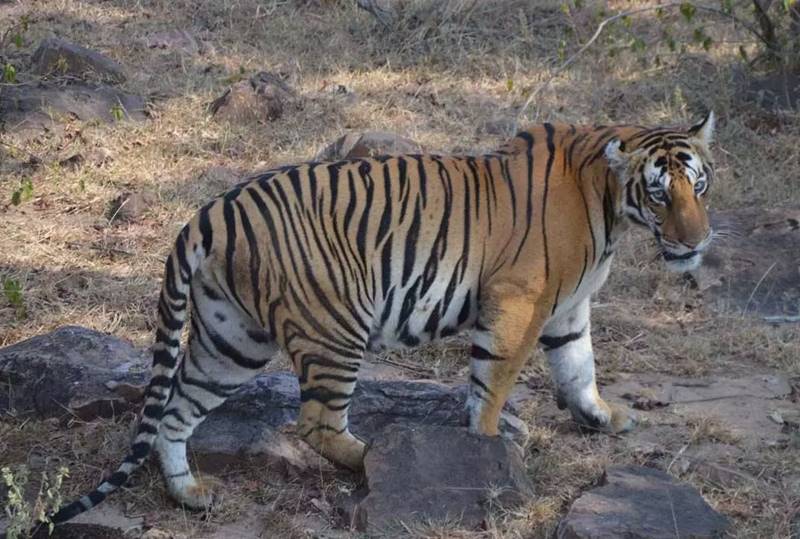The tiger real-estate of Madhya Pradesh is all set to expand with the brand new Dr Bhimrao Ambedkar Wildlife Sanctuary in Bundelkhand region in Sagar district. The sanctuary project was recently sanctioned by the chief minister of Madhya Pradesh, Shivraj Singh Chauhan at a meeting of the state wildlife board. The initiative was mooted in order to enhance and protect wildlife in the state.
The proposed sanctuary will cover 258.64 square kilometres of forest that comes under the north Sagar forest department. Dr Bhimrao Ambedkar Wildlife Sanctuary will have the Dhasan river as well as several other streams flowing through it.
The dense forests and plentitude of water in the area has made this a haven for wild animals. A favourite haunt of leopards, a lot of tigers prowl the area too. Tigers from the Panna Tiger Reserve are often found in this part of the forest.
In 2012, the male tiger P-211 had wandered into the Sagar forests, proving that there is a corridor that is used by the animals between Panna and Sagar.
Villages inside the proposed sanctuary
There are 88 villages within a five kilometres circumference of the proposed sanctuary. The people in these villages gather firewood, etc, from the forests, and often take their cattle to graze there.
According to Kunwar Vijay Shah, forest minister, Madhya Pradesh, the people in the area were annually using 98.2 cubic metres of timber and 236 cubic metre of firewood worth about Rs 5 million annually. But, once the area is declared a wildlife sanctuary, this will gradually stop as will the grazing of cattle in these forests. Usually, in such cases the people are provided firewood, bamboo, etc., at subsidised rates from the government.
Also Read: Madhya Pradesh hikes entrance fee to tiger reserves; forest guides unhappy with the decision
Forty two officers will be posted at the sanctuary including a deputy divisional officer, a forest ranger, and forest guards. Once it starts functioning, the sanctuary is expected to cost the exchequer Rs 14.8 million annually.
Interconnecting sanctuaries
The new sanctuary is important for the tigers of Panna. In 2015, a report by the World Wide Fund for Nature (WWF) assessed the natural habitat of the tigers of the Panna Tiger Reserve. The report, titled Connecting Habitat Corridors for Tigers in Panna Landscape, also brought home the importance of the Sager forest division for the tigers of the reserve.
According to the WWF study, the south west corridor of the Panna Tiger Reserve traversed through the forests in the districts of Panna, Chhatarpur, Damoh, Sagar and Katni, connecting them.
Between 2009 and 2014, this corridor was frequented by four tigers, including the tiger P-211. The Panna corridor extends till Sagar and if the new sanctuary does come about, then the sanctuaries of Sagar, Panna and Nauradehi will be interconnected.
“Establishing the sanctuary will reinforce the fact that this is a region rich in wildlife, and the density of animals will also increase,” Uttam Kumar Sharma, field operator, Panna Tiger Reserve, told Gaon Connection.
According to Sharma, most of the areas within the tiger reserves across the state already have optimum tigers in them. “The new generation of tigers are forced to disperse because of this. The new sanctuary will provide a home for these tigers,” Sharma pointed out. The sanctuary will also enable a considerable hike in the number of tigers, he added.
Also Read: Even tigers get lonely, like RBT38 did, and head back to Ranthambore
Stronger gene pools
“These active corridors are essential to strengthen the genepool of the tigers,” Hanumant Singh, former member of the state wildlife board, told Gaon Connection.
“The corridors will ensure the exchange of gene pools and prevent inbreeding which is not good for any species either for its survival or its health,” he explained. It was in order to prevent in-breeding and reestablish their numbers, that tigers and tigresses were brought in from different regions into Panna Tiger Reserve.
Hanumanth Singh said that Chitrakoot forest in Satna should also be declared a wildlife sanctuary. “In 2015, the tigress P-213 (22) from the Panna Tiger Reserve had wandered into the corridor connecting it to the Chitrakoot forest and made it her new address,” Singh recalled. A male tiger followed her there and soon the population of tigers in Chitrakoot increased.
“Currently, there are ten to twelve tigers and tigresses in Chitrakoot. Before this, there were no tigers here,” said the former member of the state wildlife board.
Read the story in Hindi.


















